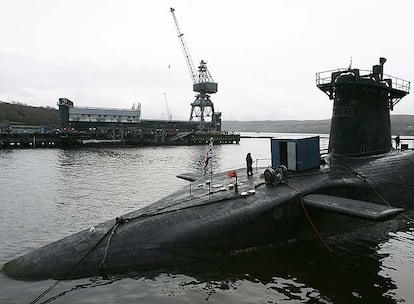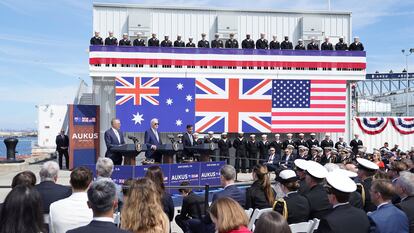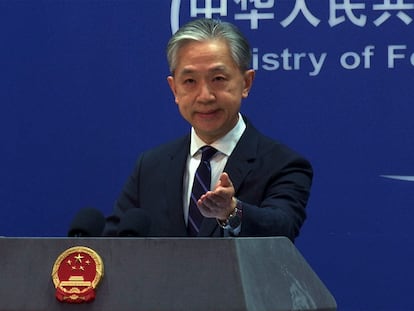The nuclear submarines angering China: Aukus, the alliance created to stand up to Beijing
The ambitious agreement between the US, the UK and Australia will enhance the allies’ influence in the Asia-Pacific and help unify their military strategies and capabilities

The Aukus security pact between the United States, the United Kingdom and Australia has already yielded its first fruit: an ambitious agreement that will give Canberra its first nuclear-powered submarines, the jewels in the crown for any Navy. The project is of great military and geopolitical significance. According to the leaders of the pact, the presence of these nuclear submarines in Australia will greatly strengthen the allies’ deterrence in the Asia-Pacific. It also marks a key step towards unifying the military strategies and capabilities of the three counties, and demonstrates to what extent the alliance wants to counteract China’s growing power.
China has been quick to condemn the nuclear submarine agreement, which was presented on Monday at the Point Loma naval base in San Diego (California), by US President Joe Biden, British Prime Minister Rishi Sunak and the head of the Australian Government, Anthony Albanese. Wang Wenbin, China’s foreign ministry spokesman, warned the three counties that they were treading a “path of error and danger,” while Russia said the deal raised questions “related to the problem of non-proliferation [of nuclear weapons].”
But the three allies have defended the agreement. “[It will] enhance our ability to deter aggression and promote our shared goal of a free and open Indo-Pacific,” said US Secretary of Defense Lloyd J. Austin III at Monday’s ceremony. The Aukus pact also looks to create new agreements in other defense fields, such as hypersonic missiles and artificial intelligence. The goal of the alliance is to provide a counterweight to China, which is seeking to modernize its army, and to respond to perceived threats from countries such as Russia and North Korea.
What is Aukus, and why was it created?
The Aukus security pact was announced on September 15, 2021. Its name is an acronym of the three participating countries. In a statement to announce the nuclear submarine agreement, US Secretary of State Antony Blinken said the partnership “deepens our longstanding diplomatic, security, and defense cooperation to meet the complex challenges of the future.” The US Department of Defense added that: “It will promote deeper information sharing and technology sharing; and foster deeper integration of security and defense-related science, technology, industrial bases and supply chains.”
While the declaration does not explicitly mention China, the partnership is a challenge to China’s growing power. Indeed, Aukus is one of many alliances the US has created or strengthened in the Asia-Pacific with the goal of curbing what it perceives as Chinese expansionism, especially around Taiwan.
In parallel, the US has reformed the informal association known as the Quad, a security dialogue between India, Australia, Japan and the US. And it has stepped up diplomatic relations with Japan and South Korea – a relationship that will strengthen when the two respective countries resolve their bilateral disputes –, and made greater overtures to South Eastern Asian countries. In the field of security, the US has promised to support the modernization of Japanese forces, and it also foresees a greater presence of US equipment and soldiers in Philippine bases.
What is the new agreement on submarines?
The pact announced Monday will provide Australia with nuclear-powered submarines. While this agreement was already included in the Aukus founding statement, it goes further than what the experts imagined at the time. Canberra will buy up to five nuclear-powered submarines (the US Virginia class or the British Vanguard class), but the three countries will also develop a new submarine model, provisionally named SSN Aukus, which is of British design. To develop a new model, the three allies will share technology.

In a first phase, Australia’s sailors will begin to familiarize themselves with the operation of the US and UK nuclear submarines. A group of these ships will rotate through military bases in Australia. Meanwhile, Canberra will gradually create an industrial base that will allow it to start manufacturing the SSN Aukus in the 2030s. Under the agreement, the United Kingdom will add the SSN Aukus to its fleet in that decade, while Australia will do so after 2040.
The pact, as highlighted by the United States, will allow Australia to modernize its industrial bases – a goal aimed at responding to China, which has more ships than Australia and is manufacturing them at greater speed.
What does the transfer of nuclear technology to Australia entail?
This step demonstrates how far the United States is willing to go to deal with its Chinese rival. It marks the first time the US has shared nuclear technology since 1958, when it made the transfer to the UK.
In announcing the project, Washington has gone to lengths to underscore its commitment to nuclear non-proliferation, and said it is in close contact with the International Atomic Energy Agency (IAEA). The US argues that just as there have been no tech leaks in the 65 years it has worked with London, there will no risk of sensitive material getting out with Australia. Canberra, for its part, has said that it does not seek to acquire nuclear weapons.
What are the advantages of a nuclear submarine over a conventional one?
A conventional diesel-powered submarine is quieter and cheaper than a nuclear one. But it has less autonomy when traveling, as it has to refuel. A diesel-powered sub is also easier to detect as it must periodically return to the surface. In contrast, a nuclear-powered submarine can travel greater distances and stay submerged for longer. It can also compensate for its increased noise by using ocean currents.
What happened between Australia and France as a result of Aukus?
Australia had struck a deal to purchase 16 diesel-powered submarines from France. When announcing its participation in Aukus, Australia indicated that it was canceling this order, which greatly angered the French government. French President Emmanuel Macron described the move as a “betrayal,” and recalled France’s ambassadors in Canberra and Washington for consultations. The dispute was settled last year after the Albanese government reached a multimillion-dollar settlement with the French military shipyard.
What obstacles may the project may encounter?
The project faces numerous challenges. Firstly, the cost of the nuclear-powered submarines is enormous. The US revealed that developing the Virginia class sub is far more expensive than what was initially budgeted. The project may also face difficulties due to the difference in regulations, ways of working and the fact that the countries are in three different time zones. What’s more, Australia must develop an industrial base to manufacture the high-tech ships practically from scratch. Then there are the potential problems that may arise from sharing information and technology, and coordinating military operations.
Sign up for our weekly newsletter to get more English-language news coverage from EL PAÍS USA Edition
Tu suscripción se está usando en otro dispositivo
¿Quieres añadir otro usuario a tu suscripción?
Si continúas leyendo en este dispositivo, no se podrá leer en el otro.
FlechaTu suscripción se está usando en otro dispositivo y solo puedes acceder a EL PAÍS desde un dispositivo a la vez.
Si quieres compartir tu cuenta, cambia tu suscripción a la modalidad Premium, así podrás añadir otro usuario. Cada uno accederá con su propia cuenta de email, lo que os permitirá personalizar vuestra experiencia en EL PAÍS.
¿Tienes una suscripción de empresa? Accede aquí para contratar más cuentas.
En el caso de no saber quién está usando tu cuenta, te recomendamos cambiar tu contraseña aquí.
Si decides continuar compartiendo tu cuenta, este mensaje se mostrará en tu dispositivo y en el de la otra persona que está usando tu cuenta de forma indefinida, afectando a tu experiencia de lectura. Puedes consultar aquí los términos y condiciones de la suscripción digital.
More information
Archived In
Últimas noticias
Most viewed
- Sinaloa Cartel war is taking its toll on Los Chapitos
- Oona Chaplin: ‘I told James Cameron that I was living in a treehouse and starting a permaculture project with a friend’
- Reinhard Genzel, Nobel laureate in physics: ‘One-minute videos will never give you the truth’
- Why the price of coffee has skyrocketed: from Brazilian plantations to specialty coffee houses
- Silver prices are going crazy: This is what’s fueling the rally











































